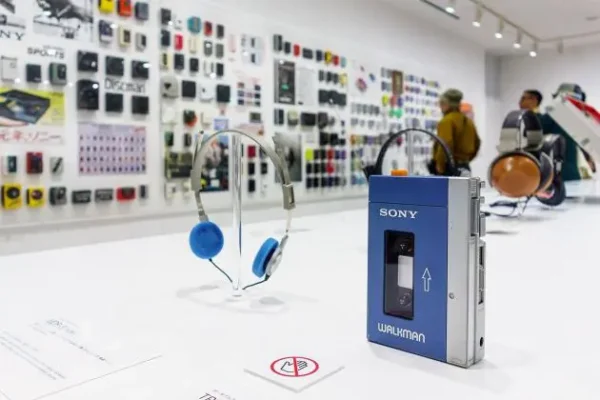Music and Dance, Music History
The Sony Eye Walkman: A Cautionary Tale of ’90s Wearable Tech

Introduction to Wearable Technology in the ’90s
The 1990s marked a significant era in the evolution of technology, where the concept of wearables began to emerge and capture the imagination of consumers. During this period, advancements in electronics catalyzed enthusiasm for innovative devices that could integrate seamlessly into everyday life. It was a time when television sets were becoming more compact and portable while music players were introducing new formats, all of which contributed to a burgeoning desire for multifunctional devices.
Among these innovations was the Sony Eye Walkman, a device that epitomized the futuristic vision of wearable technology. By promising to blend music and video into a singular, compact format, Sony aimed to revolutionize the way individuals consumed entertainment. The Eye Walkman was meant to provide users with a novel experience: watching video content and listening to audio on-the-go, an idea that felt avant-garde for its time. This was a significant leap forward in portable media consumption and highlighted the burgeoning market for personal electronics.
This excitement surrounding the potential of wearable technology during the ’90s was not limited to the Eye Walkman alone. Other companies were also exploring how technology could be integrated into clothing and accessories, signaling a shift towards a more connected lifestyle. With the advent of features like touch screens and miniaturized components, the expectation was set that technology would not only accompany users but also enhance their daily experiences in revolutionary ways. However, as we delve deeper into the story of the Sony Eye Walkman, it becomes essential to evaluate how the initial promise of these advanced wearable technologies met the reality of consumer expectations and technological limitations.
The Birth of the Sony Eye Walkman
The inception of the Sony Eye Walkman can be traced back to the late 1980s when advancements in technology began to reshape the way individuals experienced personal entertainment. Designed by Sony, a company already renowned for its innovative electronics, the Eye Walkman sought to revolutionize portable media consumption by integrating audio-visual experiences into a compact wearable device. The concept emerged from the growing demand for personal entertainment options, providing a solution that was both practical and stylish.
Launched in 1996, the Eye Walkman featured an innovative combination of a miniaturized video display and a stereo audio output, allowing users to watch music videos and movies on the go. Its design was sleek and ergonomic, equipped with a head-mounted display that offered a more immersive viewing experience. The device utilized cutting-edge technology for its time, such as a high-resolution LCD screen and high-fidelity audio production, characteristics that underscored Sony’s commitment to quality and performance.
The marketing strategy for the Eye Walkman focused on positioning it as a fashion-forward accessory for the tech-savvy youth of the ’90s. Sony identified a niche in the market for wearable devices that catered to entertainment needs without compromising style. Creative advertising campaigns highlighted its features, presenting the Eye Walkman as essential for the modern lifestyle. Consumers were captivated by the idea of portable entertainment, encouraging Sony to promote the device across various platforms, from television commercials to print ads.
Despite its promising innovations, the Eye Walkman ultimately faced challenges in user adoption, stemming from its bulky design and relatively high cost. Nevertheless, the device stands as a noteworthy attempt by Sony to merge fashion with technology, representing an important chapter in the evolution of wearable tech.
Market Reception: Hype vs. Reality
The release of the Sony Eye Walkman in the early 1990s was met with considerable anticipation, sparked by the innovative promises that the device offered. Promoted as a groundbreaking advancement in wearable technology, it aimed to merge the functionalities of a traditional Walkman with video capabilities. Pre-launch marketing efforts created a significant buzz, positioning the Eye Walkman as a revolutionary product that would redefine media consumption on the go. However, the initial reception of the device revealed a stark contrast to the excitement generated prior to its launch.
Despite the high expectations from both consumers and technology enthusiasts, sales figures illustrated a different story. The Eye Walkman struggled to meet its projected sales targets, with reports indicating that the demand was not as robust as anticipated. Consumers were intrigued by the concept of a wearable media player, yet many were deterred by its hefty price point, which was a considerable investment at the time. Furthermore, critiques of the device focused on issues related to its usability, with many users finding the product cumbersome and difficult to operate, particularly while engaging in activities that demanded attention.
Critical reviews reflected a similar sentiment, with technology experts highlighting both the ambitious vision behind the Eye Walkman and the shortcomings in its execution. Features that were initially hailed as innovative, such as its video playback capability, were often criticized for limited functionality and performance issues. As a result, the product did not garner the acclaim that Sony had hoped for and became emblematic of the challenges associated with pioneering wearable technology. The disparity between the highly marketed features and the limitations faced by consumers ultimately led to a mixed legacy for the Sony Eye Walkman, serving as a cautionary tale in the wearable tech market.
Technical Limitations and User Experience
The Sony Eye Walkman, despite its innovative concept of merging video playback with a wearable design, encountered several technical limitations that ultimately hindered its attractiveness in the consumer market. One of the most significant drawbacks was its battery life. The Eye Walkman was equipped with a power source that struggled to support extended usage. Users often reported having to recharge the device frequently, leading to interruptions during viewing sessions. This inconvenience limited the Walkman’s practicality, especially for on-the-go users who expected a longer run time.
Another noteworthy technical shortcoming was video quality. Although the device aimed to deliver a unique multimedia experience, the resolution and clarity of videos fell below the standards set by contemporary devices. Users frequently expressed disappointment, pointing out that images appeared pixelated and lacked the vibrancy found in competing video technology of the time. This insufficient video quality detracted from the overall user experience, leaving many to question the value of investing in the Eye Walkman.
Furthermore, ease of use played a crucial role in the device’s reception. The control interface, while original, was not intuitive. Users often found it cumbersome to navigate menus and settings, which led to a frustrating experience. Personal anecdotes from early adopters highlighted these issues; for instance, one user recounted how the complexity of the controls prevented them from fully enjoying their favorite films. Such user feedback emphasized that despite its futuristic appeal, the Eye Walkman failed to deliver a seamless experience, ultimately undermining its innovative potential.
In light of these technical deficiencies, the Eye Walkman serves as a reminder of the importance of balancing groundbreaking concepts with user-friendly execution in the realm of wearable technology.
The Impact of Emerging Competition
The release of the Sony Eye Walkman in the early 1990s marked a significant moment in the realm of wearable technology. However, its introduction was met with a rapidly shifting landscape of technological advancements and fierce competition. The competitive pressure was not just from similar products, but also from companies that were wise to capitalize on the growing trend of portable media consumption. As consumer preferences evolved, new competitors emerged with features that garnered substantial interest.
For instance, brands such as Apple and Nikon introduced their own variations of integrated technology that catered to a broader audience. These competitors adopted user-friendly interfaces and sleek designs, appealing to a demographic eager for practical and accessible gadgets. While the Eye Walkman carved a niche for itself, its immediate rivals boasted improvements in functionality, such as longer battery life and superior sound quality. These enhancements played a pivotal role in attracting consumers, who were increasingly drawn to devices that simplified their media experience.
The rapid evolution of digital technology during this time allowed competitors to innovate at an astonishing pace. The rise of CD players, portable cassette recorders, and eventually MP3 players revolutionized how people consumed music on the go, casting doubt on the long-term viability of the Eye Walkman. In response to these formidable emerging competitors, Sony’s ability to adapt was critically challenged. As brands began to incorporate cutting-edge features like digital displays and enhanced portability, they effectively reshaped market expectations.
This competitive environment not only influenced consumer choices but also set a precedent for future developments in wearable technology. The failure to anticipate and respond to these transformative changes left the Eye Walkman struggling to maintain its relevance amidst a thriving market that was keen on ever-improving innovations.
Lessons Learned from the Sony Eye Walkman Failure
The launch of the Sony Eye Walkman serves as a pivotal case study in the realm of wearable technology, offering several valuable lessons that continue to resonate within the industry today. One of the foremost takeaways from the Eye Walkman’s failure is the critical importance of thoroughly understanding market needs. In the 1990s, while the notion of portable media was innovative, the Eye Walkman did not cater to the primary desires of consumers, who ultimately sought convenience, practicality, and user-friendly design. Therefore, it is essential for technology developers to conduct extensive market research and focus groups prior to the product development phase to ensure that the end result aligns with consumer expectations.
Another significant lesson pertains to the role of consumer feedback in the marketing cycle. The lack of consumer engagement and feedback in the Eye Walkman’s design process hindered its ability to evolve in response to user preferences. Modern technology companies that prioritize iterative feedback loops during design and testing phases are often more successful in creating products that resonate with their audience. This adaptability can make a considerable difference in a product’s acceptance and overall market performance.
Moreover, the importance of functional design cannot be overstated. The Eye Walkman showcased a novel concept but fell short in terms of ergonomic sensibility and practical usage. Devices today must address both aesthetic appeal and functional efficiency, ensuring they offer real-world benefits without overwhelming the user. The Eye Walkman’s failure exemplifies that innovation alone is insufficient; successful wearable tech must embody a seamless integration of design, function, and user-centric principles.
Applying these lessons from the Sony Eye Walkman failure can significantly enhance the development and marketing of current and future wearable technologies. Understanding consumer needs, embracing feedback, and prioritizing functional design are essential strategies in creating successful tech solutions that stand the test of time.
Nostalgia and Cultural Impact of the ’90s Tech Boom
The 1990s marked a significant turning point in the evolution of technology, introducing innovations that not only transformed product design but also shaped consumer culture. Within this dynamic context, the Sony Eye Walkman emerged as a symbol of both ambition and miscalculation in the realm of wearable technology. This period was characterized by an insatiable appetite for gadgets that promised to enhance daily life. The Eye Walkman, with its forward-thinking design and integration of video playback, represented the pinnacle of this enthusiasm for innovation.
During the ’90s, technology permeated various aspects of life, influencing everything from fashion to communication. The eye-catching design of the Eye Walkman aimed to appeal to a demographic eager for novelty and instant gratification. Although it never achieved the widespread commercial success anticipated, the product has since maintained a nostalgic significance among those who experienced the tech boom firsthand. Many recall the thrill of the gadget’s introduction, emphasizing its ambitious attempt to merge video and mobility in a unique format. This attempt underscored not just the hopes for wearable technology, but also the limitations and pitfalls that come with such experimental endeavors.
Culturally, the Eye Walkman resonates with a sense of longing for the audacious spirit of the ’90s. It serves as a reminder of a time when technology was characterized by bold experimentation and the promise of a digital utopia. The enthusiasm that surrounded the Eye Walkman mirrors broader trends of the decade, illustrating how fleeting innovation can lead to both excitement and disappointment. Ultimately, the device stands as a cautionary tale within the narrative of tech growth, encapsulating the highs and lows of a transformative era that continues to capture the collective memory of its participants.
The ‘I Survived the ’90s Tech Boom’ Shirt: A Fashion Statement
The ‘I Survived the ’90s Tech Boom’ shirt serves as a captivating embodiment of nostalgia, resonating with individuals who lived through one of the most transformative decades in technology history. This period was marked by rapid advancements and burgeoning innovations, which profoundly altered the landscape of personal electronics, and the shirt pays homage to that era. It stands not merely as a piece of clothing, but as a cultural artifact that reflects the collective experience of those who navigated this tech-driven evolution.
For many, the ’90s were characterized by groundbreaking inventions such as the personal computer, the internet’s ascent, and the introduction of portable media devices. As such, the shirt acts as a badge of honor for those who adapted to and embraced these changes. It encapsulates memories of long-forgotten gadgets, the emergence of social media, and the mixed emotions surrounding these advances—excitement tinged with apprehension. By donning this shirt, individuals can express their belonging to a unique era defined by innovation and the sometimes chaotic integration of technology into daily life.
Today, the ‘I Survived the ’90s Tech Boom’ shirt resonates with a growing audience that values retro aesthetics and the recollection of cherished memories. The design often evokes a sense of familiarity and comfort, making it popular not just among those who directly experienced the tech boom, but also among younger generations who appreciate the charm and novelty of this bygone era. By incorporating this nostalgic piece into modern fashion, wearers bridge the gap between the past and present, illustrating how technology has shaped societal norms and individual identities over time.
Conclusion: The Legacy of the Sony Eye Walkman
The Sony Eye Walkman stands as a distinctive chapter in the annals of wearable technology, a product emblematic of the fervent experimentation that characterized the technology landscape of the 1990s. Launched amid ambitious visions for the future of personal media consumption, the Eye Walkman attempted to merge mobility with innovative audio-visual experiences. Despite its failure to gain traction among consumers, this device reflects the era’s bold approach to design and functionality, highlighting the endless possibilities that technology could provide.
As a failed product, the Eye Walkman serves as a reminder of the intricate balance that must be achieved between innovation and practicality. While many devices have been released over the years in pursuit of a visionary new frontier, the practicality of user experience often dictates their success or failure. The Eye Walkman’s unique yet cumbersome design illustrates how even the most forward-thinking ideas can fall short without careful consideration of real-world application. It encapsulates a lesson learned by many within the tech industry: the importance of not only dreaming big but also ensuring that those dreams resonate with consumers’ everyday needs.
Reflecting on its legacy, the Sony Eye Walkman has influenced subsequent generations of tech creators and innovators who are tasked with considering both creativity and usability. Modern advancements in wearable technology have drawn inspiration from the bold endeavors of the past while striving to avoid the pitfalls encountered by products like the Eye Walkman. Ultimately, this device signifies a crucial phase in technological evolution, paving the way for today’s celebrated breakthroughs. In summary, it exemplifies the fine line that exists between innovation and practicality, a delicate balance that remains essential for success in the current technological landscape.
Funny and Sarcastic
Dios de los Muertos
















